Being a proud new owner of a horse entails a lot of responsibilities. Taking good care of your horse is one of the many gargantuan tasks of a horse owner – including how to wash a horse, and how to clean them.
Washing a horse, especially if you are doing it for the first time, will seem a little intimidating.
This is completely normal!
Don’t be embarrassed because you’re a little nervous about what to do or how your horse might react. I mean, your horse is much bigger than you and it may very well be that he doesn’t like water.
The first time I had to wash a horse, I was so nervous.
I would try and avoid doing it by giving my horse tons and tons of sponge baths using a bucket! But that didn’t really work…
So, this guide is going to teach you the exact steps of how to wash a horse with safety as the #1 priority (for both you and your horse!). Furthermore, I’ll go over some tips and tricks that you can use to make sure everything goes as smoothly as possible.
You can use these bathing steps and techniques to keep your horse’s coat glistening, shiny, and clean. Soon you’ll be an expert at washing horses!
Also don’t forget to get my 100% FREE Beginner Rider’s EBook! You’ll learn how to keep a consistent pace (whether you’re riding a fast or slow horse), how to make smoothen transitions, how to finally get the flexion and bend you want, how to use the “Emergency Brake,” as well as bonus chapters on making cantering and jumping so much easier!
This post may contain affiliate links, which means we may earn a small commission if you choose to make a purchase.
Step #1: Get Your Supplies Ready
First, you’ll want to make sure you have everything you’re going to need to give your horse a bath. Here’s a list of what I recommend:
- A curry comb, dandy brush, and wide-toothed comb (if you don’t already have these basics, you can get a kit like this one that basically has everything you need).
- Dry clean towels
- A sweat scraper (like this one)
- A hose (for water supply) with an adjustable nozzle
- A bucket of clean, warm water
- Clean sponges and wet cloths
- Shampoo (here are my favorite brands)
- Other optional grooming products (conditioner, lotion, etc.)
Step #2: Prepare Your Wash Station
Now you’ll want to choose a spot where your horse can get wet and soapy. Here are a few pointers to help you choose the best location:
- Ideally, find a spot outside, preferably on a sunny, hot day. (Keep in mind that your horse is sensitive to sudden changes in temperature and can get easily chilled during the cold weather.)
- Pick a spot where you can tie up your horse with a quick-release knot or (if you have it) a quick-release clip. (This will be very helpful in case your horse gets really frisky or spooked while he’s being washed, he doesn’t hurt himself trying to run away.)
- Choose a location where the water can easily drain away.

Step #3: Brush Your Horse’s Coat & Mane
Before you actually start washing your horse, you want to go through your horse’s usual grooming ritual. (If you don’t already have a daily grooming routine established, here’s our complete guide on how to groom horses.)
If you just need a quick refresher, here are a few steps to take in order to make sure your horse’s body is free of large debris:
- You can use both a curry comb and a dandy brush to loosen any dirt. Brush off dried mud and dirt in your horse’s legs.
- Smooth and detangle the mane and tail with a wide-toothed comb. Using your fingers, work your way through the tangles and knots.
- See to it that he is calmer with the idea of you fussing with him. Never start bathing a horse that seems nervous or panicky!
Finally, be ready to get wet and dirty! (Don’t wear anything that can’t get ruined.)

Step #4: Wet Your Horse From the Hooves Up
Then you want to do is wet your horse before applying shampoo.
When you’re doing this, a good way of remembering what to do is to think of how you like to get in the water. Maybe if it’s a very hot day you’ll dive right in but generally, you’ll walk in getting your feet wet first and then work your way up to swimming.
The same thing goes for your horse!
The rule of thumb in washing a horse is to start wetting from the hooves and then work your way up to their back. Never wet your horse’s head unless he is clearly enjoying the bath and having a great time.
To do this, you can either use a hose or a sponge soaked in water. Some horses do not like getting hosed down, so this is something you should consider.
If you do use a hose, you should never use a harsh spray setting because this could spook your horse. Ideally, you want the water to run out of the hose in one smooth stream.
You’ll also want to avoid spraying or hosing directly on your horse’s sensitive areas (namely, the face, genital area, and anus). Take extra care and use gentle strokes when washing these sensitive areas.
Step #5: Do the Sensitive Areas First (WITHOUT Shampoo!)
To clean your horse’s face, you want to first take a sponge, soak it into a bucket of warm water, and squeeze off the excess water.
Then gently wipe down your horse’s face in the direction of hair growth. But do not use soap to clean your horse’s face.
If their face is really dirty, constantly replenish your bucket with clean water. Repeat this as many times as necessary in order to get your horse’s face clean.
You can tell that this horse below did not like getting soap in their eyes!

Next, you want to wash the genital and anus areas very carefully, since horses will be more prone to get spooked or upset. If you’re a beginner, you might want to have someone more experienced to help you with this part or show you how it’s done the first time, just to be safe.
For male horses, you want to take this opportunity to clean their sheath and penis. You can do this using clean cloths or cotton wool. You want to wet them and very gently wipe down the sheath and the penis.
For female horses, their genitals will be right below their anus so make sure you are not wiping towards or on this area as you can transfer harmful bacteria.
Next, you want to clean the anus of the horse. Wipe the anus gently and have fresh, clean clothes handy so you can switch every time one gets dirty.
Here are some more things to keep in mind as you clean these areas:
- Be very delicate.
- Remember to keep your eye out for any abnormalities.
- To help prevent the transfer of harmful bacteria, use a different (clean) wash cloth for these areas than you do for the rest of the body.
- It’s very important not to stand directly behind the horse but always to one side.
Step #6: Lather Your Horse’s Legs & Body Section By Section
Now it’s time to get out the shampoo and wash the rest of your horse!
Shampooing your horse section by section will help you make sure that you will not miss any spots. Also, it prevents the shampoo from staying on your horse’s coat for too long and drying out. (This will dull his coat and isn’t good for his skin.) You can think of the different sections as four quadrants: front right, front left, back right, and back left.
For each section, take a dollop of the shampoo on a cloth as instructed by the bottle and work the shampoo into your horse’s coat. Lather the shampoo onto the coat in a circular motion.
Once you’ve done lathering one section, rinse the shampoo off immediately before you proceed to put soap on the next section. Repeat these steps until you’ve washed every section.
Below you can see this Percheron has soap everywhere! Although he may look adorable with all the suds, this is not ideal because some of the areas that were soaping may already be drying out and doing some damage to the coat.
As I mentioned before, the two places you want to avoid using shampoo on are your horse’s face and genital areas. The shampoo isn’t good for these areas and may cause irritation. Also, your horse will probably not like it in their eyes—even if it’s non-stinging.

Step #7: Rinse the Shampoo Off (Before It Dries Out)
After you shampoo each section, you want to hose that section off right afterward. As mentioned above, this will prevent certain areas from drying up, which will negatively affect your horse’s coat and skin.
Again, make sure you hose your horse down with a steady stream of water. You don’t want to spray your horse with a forceful water current. This means it might take a little bit longer to get the soap off, but your horse and his coat will be a lot happier!
Step #8: Finish Up With Your Horse’s Mane & Tail
You should have already detangled and combed through your horse’s mane and tail before starting to wash them (as part of the general grooming process in step #3). It’s better to detangle the mane and tail when they’re dry to avoid breakage because the hair will be weaker when wet.
If your horse’s mane and tail aren’t wet yet, you want to wet them now.
For your horse’s tail, you can mostly dip it into a bucket full of water, shake it around and then squeeze the water out. Repeat this until the dirt is mostly out.
You can use this dunking method because wetting the tail doesn’t cool down the horse’s body at all. For the top of the tail that you can’t get into the bucket, you can wipe it down with a sponge.
Remember, as with everything you do behind your horse, don’t stand directly behind them. Always stand to one side or another so just in case the horse gets upset or scared and decides to kick.
For the mane, just use the hose to wet it.
Then, simply shampoo the mane and tale like you would with your own hair, and rinse!
You can also use mane and tail conditioner and then rinse that out also. Conditioner will make your horse’s mane and tail softer and smoother. Just make sure to follow the instructions that are outlined on the bottle.
Step #9: Dry Your Horse With a Sweat Scraper
Once there is no more shampoo residue left, you can start drying your horse.
Proper drying is very important. Never leave your horse dripping wet, especially if it’s cold or cloudy outside. The water in his coat will prevent him from properly maintaining body temperature.
Using the sweat scraper, you can scrape the excess water off your horse. Move the scraper in the same direction of the hair growth. Keep doing this until your horse is just a little bit damp. You can also wipe your horse down with towels if you don’t have access to a sweat scraper. (It will take quite a bit longer if you use towels, but it’s very important that you make sure to get them as dry as possible.)
When drying out the mane and tail, do not use a comb trying to detangle any knots. Use your fingers to gently comb through.
Once your horse is just slightly damp, you want to let them completely dry off. You can walk them for about ten minutes to get their circulation going and to warm up their muscles. After that, if it’s a warm, sunny day, you can turn them out. If it’s cold outside, very windy, or cloudy, then put a breathable blanket on them and keep them inside.
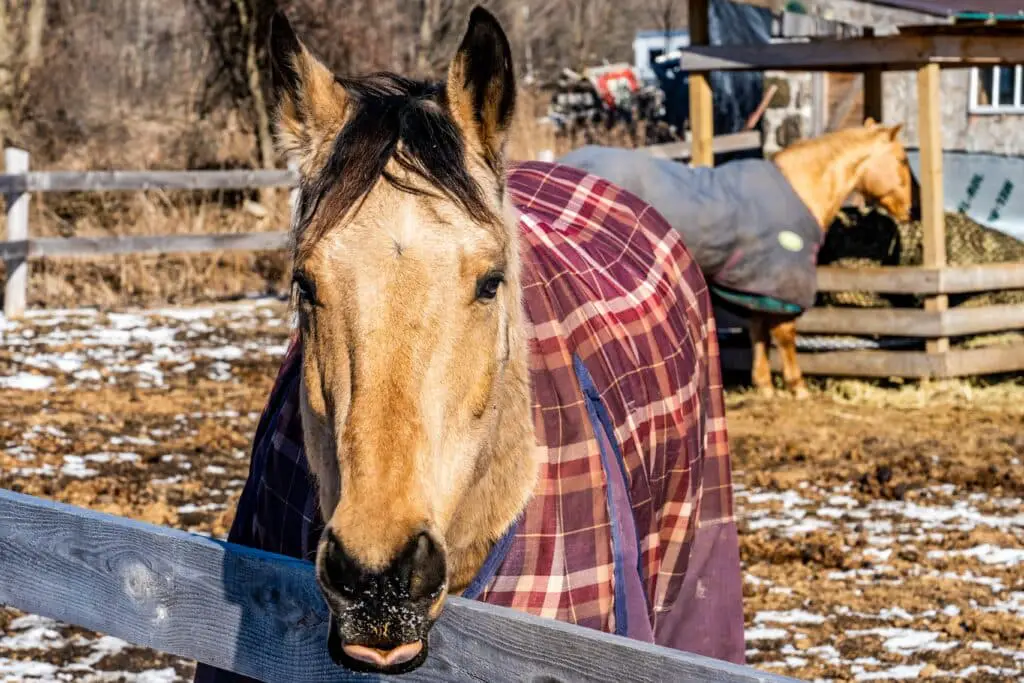
Some Specialty Tips & Tricks for How to Wash a Horse
Here are a few more things to keep in mind when bathing your horse:
- If you’re washing your horse right after riding, make sure they’re completely cooled down before you start bathing. This goes back to the fact that you really want to avoid suddenly changing your horse’s temperature. Keep everything as gradual as possible.
- For your very first wash, you might want to avoid using shampoo at all. This is just in case your horse ends up really hating water. If you don’t use shampoo then you won’t have to worry about getting it off.
- If you are handling a show animal, then washing your horse will be a little different. Show horses generally need to be shampooed more than once a month. If this is the case, they may not be as able to cope with different temperature conditions outside so you might want to stable them more often on colder, windier days.
- You also want to keep in mind that horses often like to roll right after they’re washed. This can be particularly annoying if you’re washing your horse for a show. You can’t very well go into the competition with your horse covered in mud!
- Lastly, just remember to be careful when you’re choosing shampoos and conditioners for your horse. Just like for humans, some products are a lot harsher than others. In the long run, your horse’s coat is going to look a lot duller and be less healthy if you’re using a very harsh product. How to wash a horse is partially in the tools you’re using!
- If you notice that your horse is getting out of control and they just want to bolt, the best thing to do is release them and let them go. Otherwise, you could be risking injury to your horse as they try to escape.
- If you know that your horse is not a fan of baths and it’s your first time, it’s probably a good idea to have a more experienced person around just in case.
- Lastly, if your horse is sick or injured, consult your veterinarian first before giving them a bath.
How to Clean Your Horse Without a Hose
If your horse is in desperate need of a clean but hates the water or it’s just too cold outside, you have a few other options:
Regular Grooming & Scraping
Keeping up with regular brushing and grooming practices can really go a long way in keeping your horse clean. Here’s a guide for how to do that:
But sometimes, that just might not cut it…
Vacuuming
If you can’t get all the mud off using standard grooming practices, you can try loosening the mud and dirt with a curry comb and then vacuuming it off. Some horses might be totally fine with a vacuum and others might absolutely hate it, so you need to be very careful the first time you try and vacuum around your horse. Try turning the vacuum on a low setting from a distance and see how your horse reacts.
Warm Towels or Sponges
Instead of doing an entire hose-down, you can just dip sponges, cloths, or towels in a bucket of warm water and wipe your horse down that way. Simply continue wiping and rinsing this way until your horse is clean.
More F.A.Q.s About Horse Bathing
How often should you bathe your horse?
The short answer to this question is: it depends! Horses definitely don’t need baths as often as humans do. You can wash your horse up to once a week, keeping in mind that you don’t want to shampoo them too often. Some only wash their horse once or twice a year.
If you’re getting ready for a show and want your horse to look fresh, that’s obviously a good time to give them a bath. Keep in mind that you don’t have to shampoo your horse every time. You can opt for a simple rinse down to get the dirt and mud off your horse, to cool them down, or to help relieve their sore muscles.
Can you bathe a horse with cold water?
As mentioned earlier, horses can be sensitive to drastic temperature changes, so you shouldn’t bathe them with water that’s too cold.
Can you bathe a horse in winter?
You shouldn’t wash your horse in the winter, either since the cold can make it difficult for your horse to maintain their body temperature and could potentially lead to illness. If you need to clean your horse in the cold weather, we suggest using one of the waterless methods above!
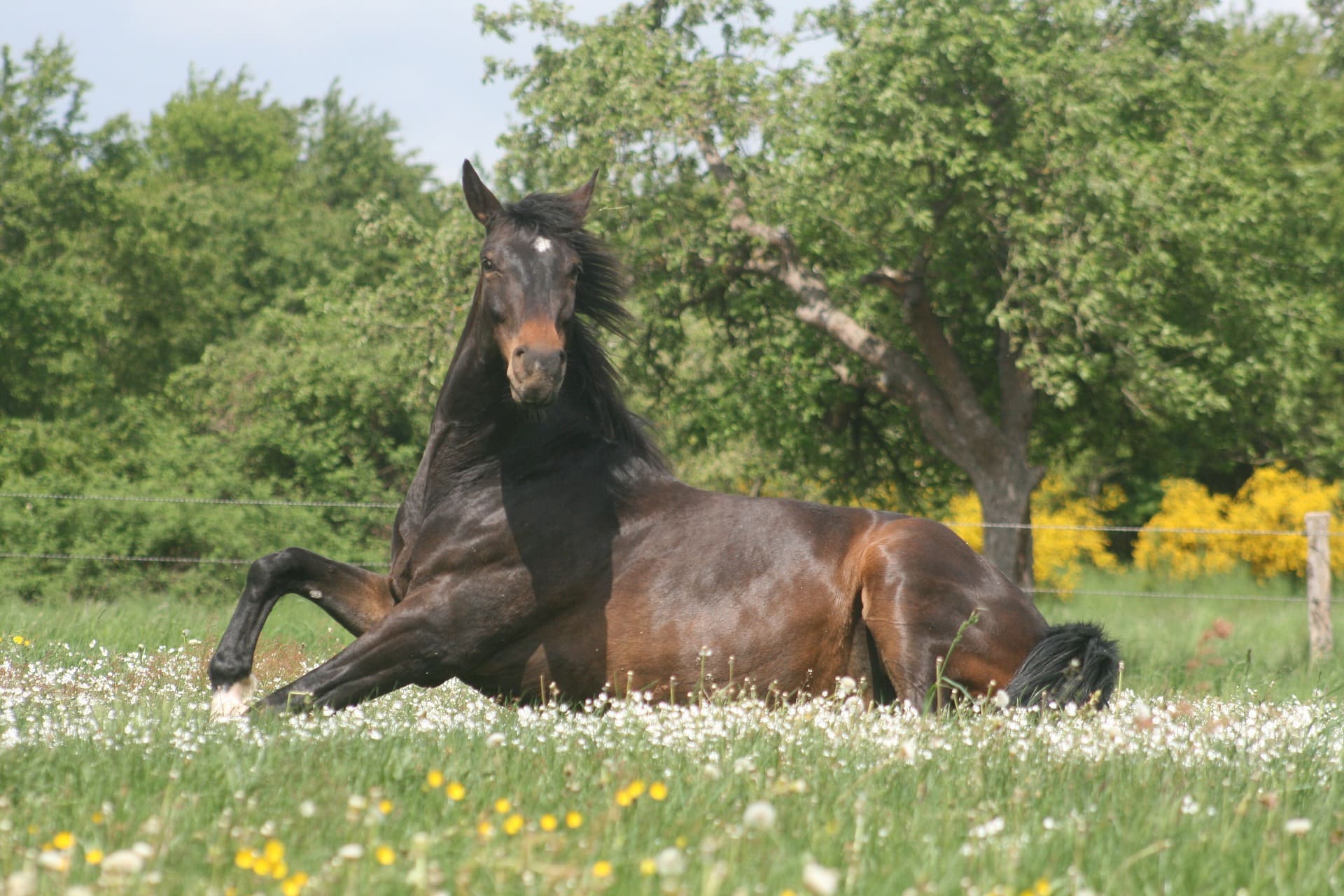
Conclusion: Main Things to Remember
Above all else, remember to stay safe and keep your horse safe. Always use common sense. Try and put yourself in your horse’s position, remembering that your horse is a flight animal and runs when they’re scared.
Also, keep in mind that everything you’re doing needs to be gradual and gentle. Don’t be too sudden with temperature changes, don’t pull or tug on your horse suddenly, and definitely don’t scream, run, or jump. All of these things may spook your horse and put both you and them in danger.
Other than that, how to wash a horse is pretty simple: wet, lather, rinse, and repeat (except for sensitive areas that are cleaned only with water, of course!). Then, dry everything as much as possible so your horse doesn’t chill.
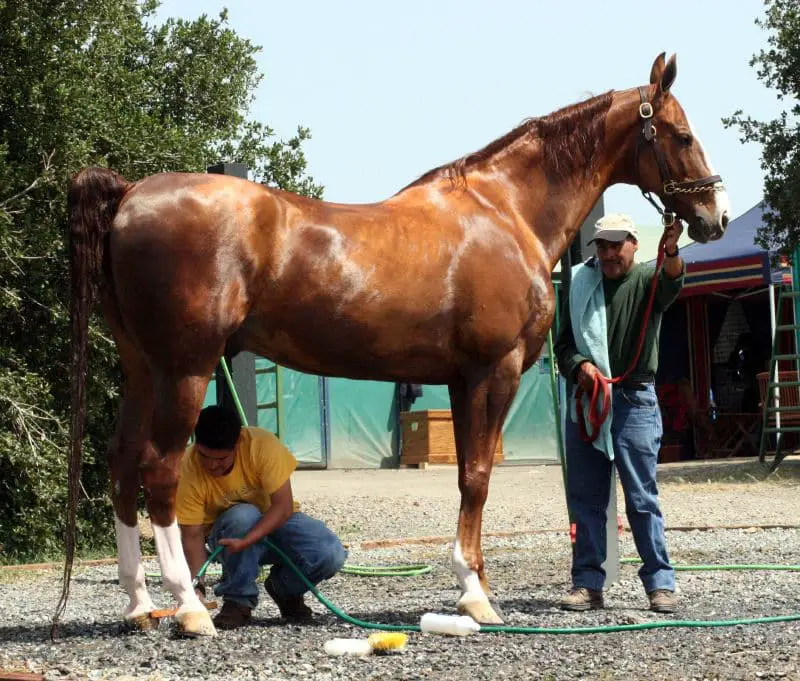
If you follow this guide and do it a few times, soon you’ll be so comfortable bathing horses. Other people will be asking you how to wash a horse!
If you have any specific questions about how to wash a horse or questions about your horse in general, don’t hesitate to ask them below and I’ll be more than happy to help. 🙂
Happy riding!
Martina
Like this post? Why not share it!

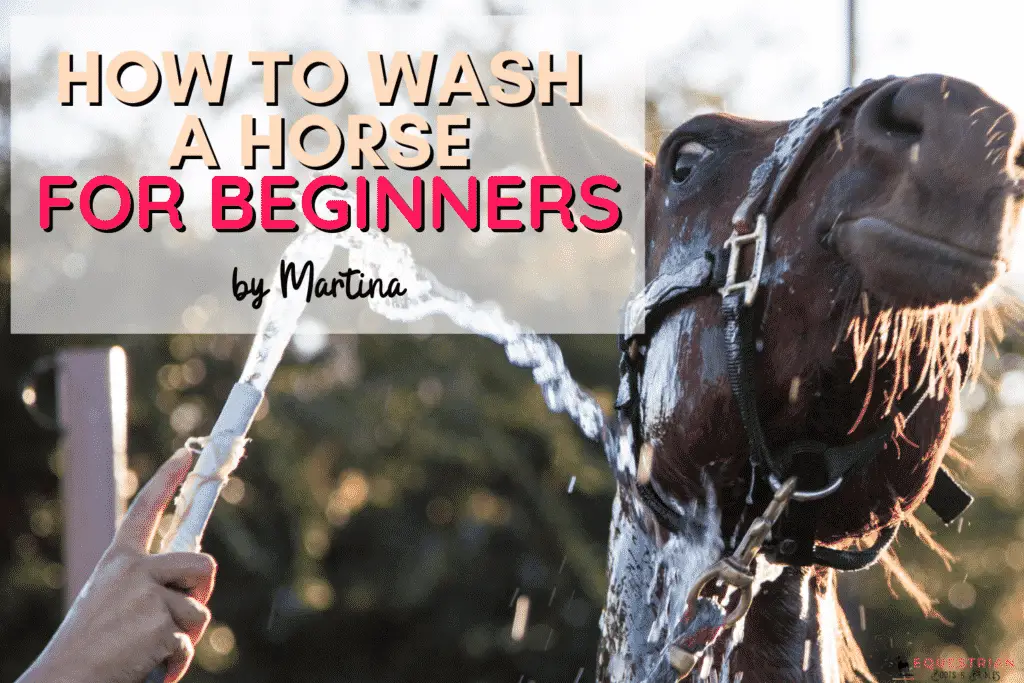

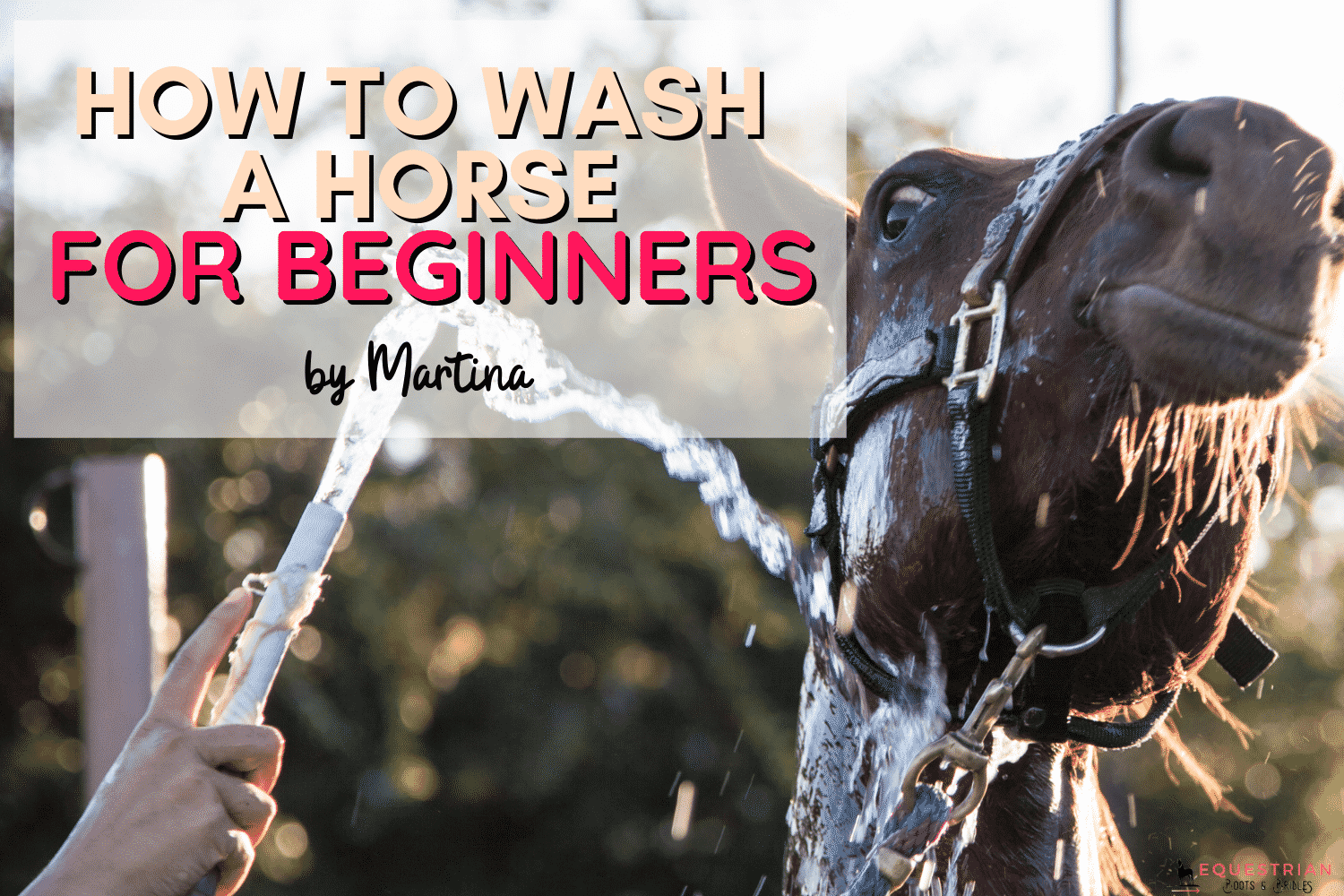
Awesome tips on caring for horses. I never knew there was so much involved! You explained the steps well in an easy to understand way and I can tell you have a lot of experience in what’s best for horses. Your site looks to be a great resource!
Hey David!
Thanks so much for your positive feedback 🙂 It seems quite exhaustive at first when you read it especially for a beginner but you’ll find that once you do it a few times it all becomes quite automatic.
Hi Martina,
What a great article, I was absorbed by the reading!
I love horses. This is one of my favorite passions:)
In fact, I’ve grown up with horses, and I also owned one a few years ago. My horse didn’t know what a bridle or a saddle was. She was wild when I bought her, she didn’t even know what is a carrot, can you imagine:)
Well, I had a good time! However, when I wanted to wash her I was opening the water far away from her until she calmed down, she was running and jumping around me, and when she stopped then, I also stopped until she got use it. After that, she starts to love water.
You have given a lot of great suggestions for beginners. Thank you very much! I look forward to reading other excellent articles!
Hey Daniella!
I’m glad that you enjoyed reading the article – horses are a passion of mine as well (in case you haven’t noticed! haha). I’m sure you took your time introducing her to everything. But in some ways this is the most amazing way of bonding with your horse. By teaching her everything, she has established a level of trust in you that she can’t possible have with anyone else now and that’s so beautiful don’t you think?
And yes, this is definitely to be expected with horses that are not used to baths! You did very well with her because if she loves water now, it’s because she’s had pleasant experiences with it. A lot of horses don’t like being bathed even after they’ve had it done a hundred times simply because their owner or whoever is bathing them isn’t paying attention to the temperature, where they are spraying the water, the water pressure and all the other things they should be. Great work 🙂
Hello there,
Horses are indeed like us. We just have to take of them just like taking care of ourselves. The tips are useful but then again, there is a possibility that even for the first time, the bath will not go smoothly. It will eventually, after a few times, that we have the know-hows and just do it routinely. It’s just a matter of discovering it’s own preferences of bath.
Hi Tar,
That is indeed correct – and yes of course! Just like sometimes we’re in a bad mood and nothing can make us feel better, sometimes a horse will just not want to be bathed. And that’s completely okay. And yes, some horses will like having the water a bit colder, some a bit warmer. Some horses are more like princesses than others who role with whatever. Horses have their own quirks and personalities which is exactly why we love them so much!
Hi there,
Thanks for the tips. I am a newbie in this and am very worried that my horse will not like the idea of me washing him. He is so used to professional hands and I worry that he will have tantrums if I try to bathe him! So this article was actually super useful for me!
Thanks!
Hi Pitin,
No problem! I’m really glad that it helped you out even if only to boost your confidence when trying to bathe him for the first time. I wish you the best of luck – let me know how it goes 🙂